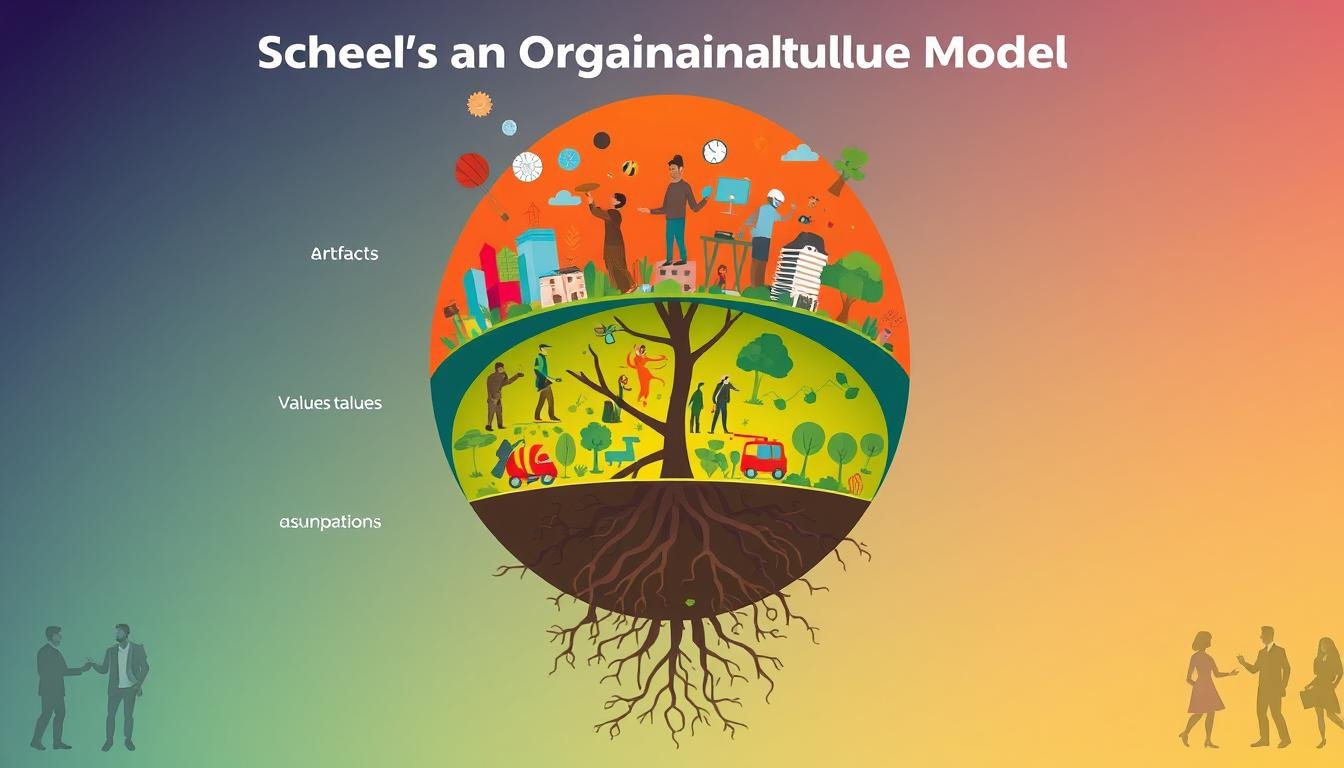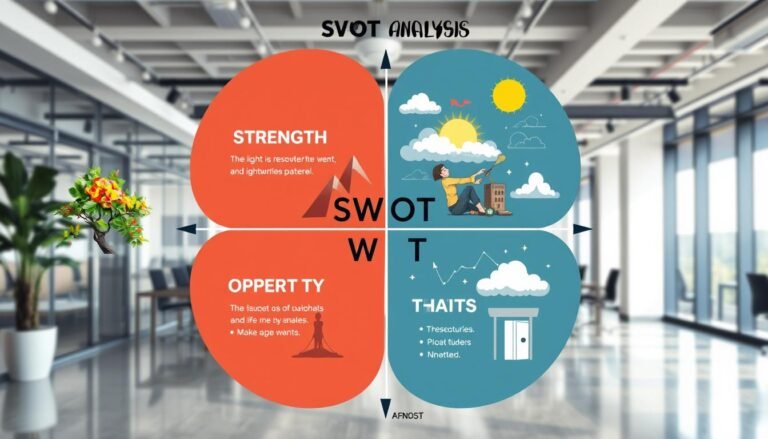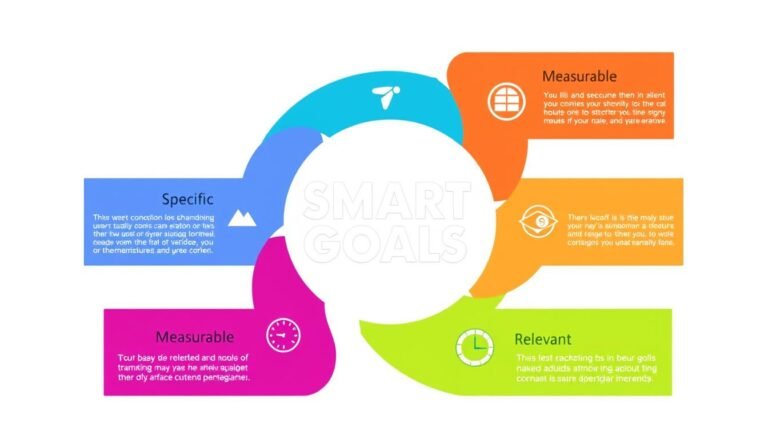Exploring Schein’s Organizational Culture Model
What if the key to success in organizations isn’t in strategy or tech, but in understanding the culture? Edgar Schein’s model sheds light on the complex world of organizational culture. He breaks it down into three main parts: artifacts, values, and assumptions. By looking at these, we can see how they shape employee actions and how well the organization does.
This deep dive changes how we see culture in a workplace. It shows us the true power of culture in an organization.
Key Takeaways
- Edgar Schein’s Organizational Culture Model consists of three layers: Artifacts, Espoused Values, and Underlying Assumptions.
- Artifacts are visible elements that reflect an organization’s culture but provide limited insight.
- Espoused Values contribute to a deeper understanding of culture, indicating organizational beliefs and behaviors.
- Underlying Beliefs are the core drivers of culture, representing fundamental assumptions about success and failure.
- Leadership significantly influences organizational culture and can drive changes in espoused values and underlying beliefs.
- Schein’s model can assist organizations in aligning their culture with strategic objectives and enhancing leadership development programs.
- Understanding and analyzing these cultural layers can lead to targeted interventions for improvement.
Understanding Organizational Culture
Organizational culture is key to how an organization works and how its people interact. It helps leaders and employees work better together. This creates a positive and productive place to work.
Definition of Organizational Culture
Organizational culture is about shared values, beliefs, and assumptions. These shape how people communicate and do their jobs. Schein’s Model breaks it down into three parts: visible actions, values, and deep beliefs.
Importance of Organizational Culture in the Workplace
Organizational culture is very important for a business. It helps keep employees happy and working well together. It also helps the company perform better and work as a team.
Leaders who understand Schein’s Model can change the culture for the better. This makes the organization more adaptable, innovative, and successful in the market.
Edgar Schein: Pioneer of Organizational Culture
Edgar Schein is a key figure in understanding organizational culture. He has worked for over six decades at MIT Sloan School of Management. His work has greatly influenced the field. Schein showed how culture affects behaviors, leadership, and how well an organization does.
Background and Contributions of Edgar Schein
Edgar Schein was born in 1928 and wrote many books on social sciences. His book, “Organizational Culture and Leadership,” from 1985, is a key resource for studying organizational culture. Schein found that organizations have three levels of culture: artifacts, values, and assumptions. This idea helps us see how culture shapes behavior and decisions at work.
The Impact of Schein’s Research on Organizational Dynamics
Schein’s work has changed how we view leadership. He talked about humble inquiry, where leaders ask questions to build relationships, not just give orders. His methods for changing organizations focus on things like how well people perform, who gets hired, and how resources are shared. This helps leaders deal with the complex world of organizational culture.
Schein’s model shows how a culture can either succeed or fail based on the behaviors it encourages. For example, comparing Organization A and Organization B shows how different cultures affect employee engagement and the work environment.
Overview of Schein’s Organizational Culture Model
Edgar Schein’s Organizational Culture Model is key to understanding what makes a company’s culture. It shows how different parts work together to shape behavior. Since 1980, this model has shown us the depth of culture, from what we see to what we don’t.
Introduction to the Model’s Framework
Schein’s model breaks culture into three main parts. The first is artifacts, like what people wear or how offices are set up. The second is values, the beliefs and values that guide actions and choices. The third is assumptions, deep beliefs that shape the culture but are often not spoken.
The Significance of Culture in Organizations
Knowing about Schein’s Levels of Organizational Culture is key for leaders who want to change things. Changing culture means looking at all levels, especially the deep beliefs that guide actions. Just changing the look of a company isn’t enough for lasting change.
Real change needs a big effort from top leaders and HR. They must talk with employees to understand the heart of their culture.
| Level of Culture | Description | Examples |
|---|---|---|
| Artifacts | Visible elements within an organization | Office design, dress codes, published materials |
| Espoused Values | Stated values and norms guiding behavior | Company mission statement, principles of conduct |
| Underlying Assumptions | Deeply embedded beliefs influencing behavior | Core beliefs about customer service, teamwork |
Using Schein’s model helps companies better understand and work with their culture. This ensures actions match goals, creating a better workplace.
Three Levels of Schein’s Culture Model
Schein’s Three Levels of Culture help us understand how organizations work. They show us three main parts: artifacts, espoused values, and underlying assumptions. Each part plays a big role in shaping the culture of a company. This affects how employees act and how well the organization does.
Artifacts: Observable Elements of Culture
Artifacts are the things we can see in a company’s culture. They include things like office design, what people wear, and the language used. For example, Amazon’s unique dome-shaped headquarters shows off the company’s innovative side. These visible parts tell us a lot, but they don’t show everything about the culture.
Espoused Values: The Organizational Narrative
Espoused values are the beliefs and ideas a company shares openly. They’re found in mission statements and what the company stands for. Oracle sees good communication as key to its success, showing how important it is for a supportive work environment. But, it’s crucial that these values match what the company actually does.
Underlying Assumptions: The Core Beliefs That Drive Behavior
Underlying assumptions are the deep beliefs that shape how people see things and act at work. They greatly affect the workplace. For instance, Facebook’s positive culture comes from these beliefs. On the other hand, Amazon’s tough work culture is also due to these beliefs. Knowing these beliefs helps leaders fix cultural issues.
Organizational Culture Model (Schein)
Schein’s Organizational Culture Model shows how three levels work together to shape how a company acts. These levels are artifacts, espoused values, and underlying assumptions. Artifacts are the visible parts like symbols and behaviors. Espoused values are the beliefs and norms a company says it values. Underlying assumptions are the deep beliefs that guide actions and decisions.
Leaders can use this model to understand their company’s culture and fix any issues that affect performance.
Exploring the Interaction Between the Three Levels
The way artifacts, espoused values, and underlying assumptions work together is key to understanding a company’s culture. Artifacts, like the office setup and what people wear, show what the company values. But, these must match the company’s real values.
Leaders need to act in a way that matches the company’s values and deep beliefs. If not, it can hurt trust and engagement among employees.
How Leaders Can Impact Organizational Culture
Leaders are crucial in shaping and keeping a company’s culture. They should act in ways that show the culture they want. For example, if leaders live by the company’s values, it encourages employees to do the same.
This approach helps create a strong culture. By using Schein’s Model, leaders can improve communication and make a place where growth and teamwork thrive. This approach not only boosts performance but also helps in keeping good employees, which is good for the company’s future.
Source Links
- Edgar Schein’s Organizational Culture Triangle: A Simple Summary – The World of Work Project
- Schein’s Organizational Culture Model
- Schein’s Model: Unpacking Organizational Culture Layers
- Organisational Culture: The Edgar Schein Model
- 5 enduring management ideas from MIT Sloan’s Edgar Schein | MIT Sloan
- Edgar Schein Model of Organization Culture
- Schein’s Model of Organizational Culture
- Edgar Schein Model – Organisational Culture – BusinessBalls.com
- What Are the Three Levels of Organizational Culture: Schein’s Three Levels of Organizational Culture
- Edgar Schein’s three levels of organizational culture
- Edgar Schein Models on Organizational Culture – Culture Partners







